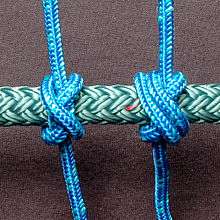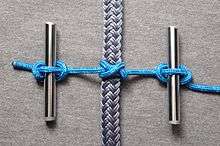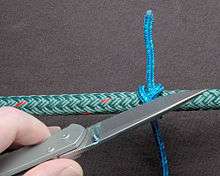Constrictor knot
| Constrictor knot | |
|---|---|
 Left: constrictor knot Right: double constrictor knot | |
| Names | Constrictor knot, gunner's knot |
| Category | Binding |
| Related | Clove hitch, transom knot, strangle knot, miller's knot, boa knot, cross constrictor knot |
| ABoK | #176, #355, #364, #430, #1188, #1189, #1249, #1250, #1251, #1252, #2052, #2097, #2489, #2560, #3441, #3700, #3853 |
The constrictor knot is one of the most effective binding knots.[1][2][3][4] Simple and secure, it is a harsh knot that can be difficult or impossible to untie once tightened. It is made similarly to a clove hitch but with one end passed under the other, forming an overhand knot under a riding turn. The double constrictor knot is an even more robust variation that features two riding turns.
History
First called "constrictor knot" in Clifford Ashley's 1944 work The Ashley Book of Knots, this knot likely dates back much further.[5] Although Ashley seemed to imply that he had invented the constrictor knot over 25 years before publishing The Ashley Book of Knots,[1] research indicates that he was not its originator.[6] Ashley's publication of the knot did bring it to wider attention.[7]
Although the description is not entirely without ambiguity, the constrictor knot is thought to have appeared under the name "gunner's knot" in the 1866 work The Book of Knots,[8][9] written under the pseudonym Tom Bowling.[lower-alpha 1] in relation to the clove hitch, which he illustrated and called the "builder's knot". He wrote, "The Gunner's knot (of which we do not give a diagram) only differs from the builder's knot, by the ends of the cords being simply knotted before being brought from under the loop which crosses them."[10] Oddly, when J. T. Burgess copied from Bowling, he changed this text to merely state "when the ends are knotted, the builder's knot becomes the gunner's Knot."[11] Although this clove hitch with knotted ends is a workable binding knot,[lower-alpha 2] Burgess was not actually describing the constrictor knot. In 1917, A. Hyatt Verrill illustrated Burgess' clove hitch variation in Knots, Splices and Rope Work.[12]
The constrictor knot was clearly described but not pictured as the "timmerknut" ("timber knot") in the 1916 Swedish book Om Knutar ("On Knots") by Hjalmar Öhrvall.[13] Finnish scout leader Martta Ropponen presented the knot in her 1931 scouting handbook Solmukirja ("Knot Book"),[14] the first published work known to contain an illustration of the constrictor knot.[5] Cyrus L. Day relates that, "she had never seen it in Finland, she wrote to me in 1954, but had learned about it from a Spaniard named Raphael Gaston, who called it a whip knot, and told her it was used in the mountains of Spain by muleteers and herdsmen."[7] The Finnish name "ruoskasolmu" ("whip knot") was a translation from Esperanto, the language Ropponen used to correspond with Gaston.[5]
Tying
The method shown below is the most basic way to tie the knot. There are also at least three methods to tie the constrictor knot in the bight and slip it over the end of an object to be bound.[15][16][17]

- Make a turn around the object and bring the working end back over the standing part.
- Continue around behind the object.
- Pass the working end over the standing part and then under the riding turn and standing part, forming an overhand knot under a riding turn.
- Be sure the ends emerge between the two turns as shown. Pull firmly on the ends to tighten.
Variations
Double constrictor knot
If a stronger and even more secure knot is required an extra riding turn can be added to the basic knot to form a double constrictor knot. It is particularly useful when tying the knot with very slippery twine, especially when waxed.[2] Adding more than one extra riding turn does not add to its security and makes the knot more difficult to tighten evenly.

- Make a turn around the object and bring the working end back over the standing part.
- Make a second turn following the same path as the first
- Pass the working end over the standing part, then thread it back under the standing part and both riding turns, forming an overhand knot under two riding turns.
- Be sure the ends emerge between the turns as shown. The double constrictor may require more careful dressing to distribute the tension throughout the knot. After working up fairly tight, pull firmly on the ends to finish.
Slipped constrictor knot
This variation is useful if it is known beforehand that the constrictor will need to be released. Depending on the knotting material and how tightly it is cinched, the slipped form can still be very difficult to release.

- Make a turn around the object and bring the working end back over the standing part.
- Continue around behind the object, and then again over the standing part back to the side of the first turn.
- Pass a bight of the working end under the point where the first riding pass and the standing part cross to form a slip loop.
- Be sure the slip loop bight and both ends emerge from in between the two turns as shown.
- To release, tug on the working end so that the bight passes back through the knot.
The slipped constrictor can also be tied in the bight and slipped over the object to constrict. Despite its advertised advantage (quick release), the slipped constrictor knot can also be hard to release when worked extremely tight in certain rope materials.
Usage

The constrictor knot is appropriate for situations where secure temporary or semi-permanent binding is needed. Made with small-stuff it is especially effective, as the binding force is concentrated over a smaller area. When tying over soft material such as the neck of a bag, hard stiff cord is more effective. When tying over hard surfaces, soft stretchy line is preferred. The constrictor knot's severe bite (which makes it so effective) can damage or disfigure items it is tied around.[3] To exert extreme tension on the knot without injuring the hands, one can fashion handles using marlinespike hitches made around two rods.[2]
Constrictor knots can be used for temporarily binding the fibres of a rope (or strand ends) together while splicing, or when cutting to length and before properly whipping the ends. Constrictor knots can also be quite effective as improvised hose clamps or cable ties. The knot has also been recommended for ligatures in human and veterinary surgery, where it has been shown to be far superior to any of the knots commonly used for ligation.[4] Noted master-rigger Brion Toss says of the constrictor: "To know the knot is to constantly find uses for it…"[2]
Releasing

A heavily tightened constrictor knot will likely jam. If the ends are long enough, one can sometimes untie it by pulling one end generally parallel to the bound object and a bit up away from it, and prying it into the opposite end's part to open the knot. Tools that can be forced between parts of the knot (such as picks and marlinespikes) may help.
If the ends have been trimmed short, or the knot is otherwise hopelessly jammed, it can be easily released by cutting the riding turn with a sharp knife. The knot will spring apart as soon as the riding turn is cut. If care is taken not to cut too deeply, the underlying wraps will protect the bound object from being damaged by the knife.[18]
Security
The constrictor and double constrictor are both extremely secure when tied tightly around convex objects with cord scaled for the task at hand. If binding around a not fully convex, or square-edged object, arrange the knot so the overhand knot portion is stretched across a convex portion, or a corner, with the riding turn squarely on top of it.[2] In situations where the object leaves gaps under the knot and there are no corners, it is possible to finish the constrictor knot off with an additional overhand knot, in the fashion of a reef knot, to help stabilize it. Those recommendations aside, constrictor knots do function best on fully convex objects.
If the constricted object (such as a temporarily whipped rope) ends very close to where a constrictor binds it, a boa knot may prove a more stable solution.
Notes
- ↑ The name "Tom Bowling" was widely associated with nautical themes, see The Adventures of Roderick Random and Charles Dibdin. The Book of Knots is most often attributed to Paul Rapsey Hodge or Frederick Chamier. For additional discussion see Ashley(1944), p. 11.
- ↑ A clove hitch finished with a full reef knot is still used for securing cabling in aerospace applications. See Cable lacing#Styles.
References
- 1 2 Clifford W. Ashley, The Ashley Book of Knots (New York: Doubleday, 1944), 224-225.
- 1 2 3 4 5 Brion Toss, The Complete Rigger's Apprentice (Camden, Maine: International Marine, 1998), 10-13.
- 1 2 Geoffrey Budworth, The Complete Book of Knots (London: Octopus, 1997), 136-139.
- 1 2 Taylor, Howard; Grogono, Alan W. (March 2014). "The constrictor knot is the best ligature". Annals of the Royal College of Surgeons of England. 96 (2): 101. doi:10.1308/003588414X13814021677638.
- 1 2 3 Cyrus Lawrence Day, The Art of Knotting and Splicing, 4th ed. (Annapolis: Naval Institute Press, 1986), 112.
- ↑ Johansson, Sten (April 1983), "Letters", Knotting Matters, London: International Guild of Knot Tyers (3): 13–14
- 1 2 Cyrus Lawrence Day, Quipus and Witches' Knots (Lawrence: The University of Kansas Press, 1967), 110-111.
- ↑ Pieter van de Griend (1992). A Letter to Lester. Århus: Privately published. ISBN 87-983985-0-4.
- ↑ Pieter van de Griend (July 2007). "The Constrictor Knot Revisited". Knot News. International Guild of Knot Tyers - Pacific Branch (62). ISSN 1554-1843.
- ↑ Bowling (pseudonym), Tom (1890) [1866], The Book of Knots (6th ed.), London: W. H. Allen, p. 8,
- ↑ Joseph Tom Burgess, Knots, Ties, and Splices (London: George Routledge & Sons, 1884), viii, 101.
- ↑ A. Hyatt Verrill, Knots, Splices and Rope Work, Third Revised Edition (New York: Norman W. Henly Publishing Co., 1917; 2006 Dover republication), 33-35. (second revised edition online)
- ↑ Hjalmar Öhrvall, Om Knutar, Second edition, (Stockholm: Albert Bonniers Förlag, 1916), 78.(Online version)
- ↑ Martta E. Ropponen, Kaarina Westling illustrator, Solmukirja, Suomen Partioliiton Kirjasia N:4 (Porvoo, Finland: WSOY, 1931), 58-59.
- ↑ "Constrictor Knot: Twisting Method". Retrieved 4 May 2014.
- ↑ "Constrictor Knot: Folding Method". Retrieved 4 May 2014.
- ↑ "Constrictor Knot: Instrument Method". Retrieved 4 May 2014.
- ↑ Geoffrey Budworth, The Ultimate Encyclopedia of Knots (London: Hermes House, 1999), 159.
External links
| Wikimedia Commons has media related to Constrictor knots. |
- Grog. "Constrictor Knot". Animated Knots. Retrieved April 2013. Check date values in:
|access-date=(help)